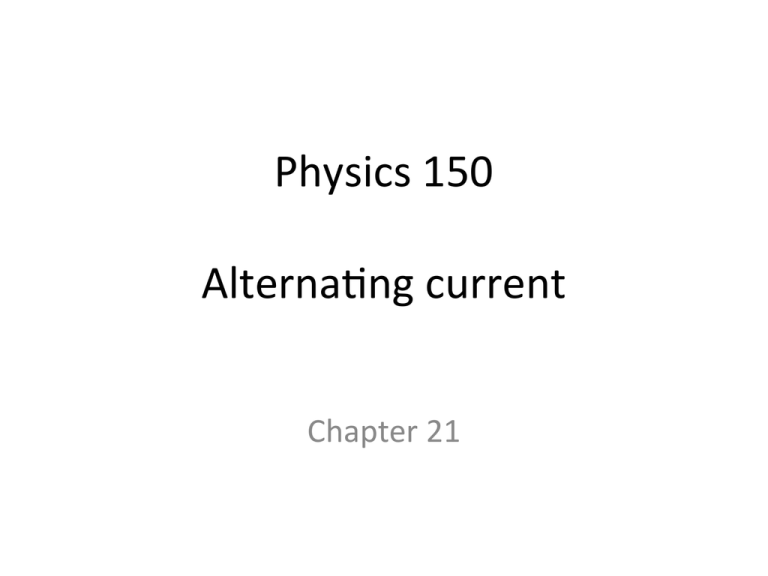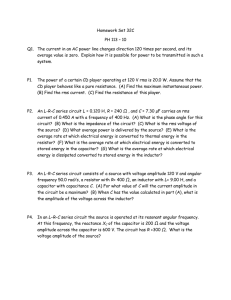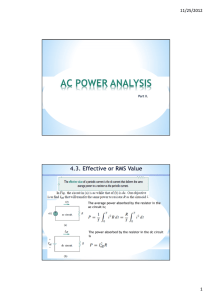21 Alternating Current
advertisement

Physics 150 Alterna2ng current Chapter 21 Electric generators A coil of wire turns in a magne2c field. The flux in the coil is constantly changing, genera2ng an EMF in the coil. ε = NBAω sin ωt A – area N – number of turns ω – angular speed ε max ε max = NBAω −ε max If this loop is part of a circuit, this EMF will induce an Alterna(ng Current (AC) in the circuit. 2 Physics 150, Prof. M. Nikolic Sinusoidal voltage ε (t) = ε max sin ω t T • Maximum EMF (εmax) is called the amplitude (peak) of the EMF • ω is angular speed and has units radians per second [rad/s] Physics 150, Prof. M. Nikolic 3 Period and frequency – digression to Chapter 5 – The frequency (f) is the number of complete oscilla2ons per second. Units: Hertz [Hz] (1/s) The period (T) is the 2me required for one cycle of periodic mo2on, i.e. peak to peak, boWom to boWom. Units: seconds [s] 1 T= f Angular velocity ω = v 2π = 2π f = T T One full oscilla2on: 2π rad = 3600 Physics 150, Prof. M. Nikolic 4 Sinusoidal currents The current in a resistor is s2ll given by Ohm’s Law: ε (t) ε max I(t) = = sin ω t = I max sin ω t R R Maximum current (Imax) is also called the amplitude (peak) of the current. ε max I max = R Note that different literature is using different nota2on (i.e. amplitude of the current: Imax, I0, A,…) but we are s2ll talking about the same variable. Physics 150, Prof. M. Nikolic 5 Power dissipated in a resistor Since both the current and the voltage are changing, the power dissipated by a resistor will change with 2me: P = I(t)ΔVR (t) P = ( I max sin ω t ) ( ΔVmax sin ω t ) P = I max ΔVmax sin 2 ω t ΔVmax is the maximum (amplitude) voltage across the resistor; it may be equal to εmax but it does not have to be. What about the average power dissipated by a resistor? The average value sin2ωt over one cycle is 1/2. Physics 150, Prof. M. Nikolic 1 Pav = I max ΔVmax 2 6 RMS values What are the averages of ΔV(t) and I(t) over one cycle? The “problem” here is that the average value of sin ωt over one complete cycle is zero! This is not a useful way to characterize the quan22es V(t) and I(t). That is why, we are going to introduce a root mean square (rms) as the characteris2c value over one cycle I max I rms = 2 ΔVmax and ΔVrms = 2 The average power is then 1 I ΔVmax Pav = I max ΔVmax = max 2 2 2 Physics 150, Prof. M. Nikolic 2 ΔV 2 Pav = I rms ΔVrms = I rms R = rms R 7 Exercise: RMS values A circuit breaker trips when the rms current exceeds 20.0 A. How many 100.0 W light bulbs can run on this circuit without tripping the breaker? (The voltage is 120 V rms.) What is given: Irms,max = 20.0 A W = 100.0 W ΔVrms = 120 V Each light bulb dissipates power given by: 2 ΔVrms Pav = I rms ΔVrms = I R = R 2 rms This means that each light bulb draws current: I rms = I rms = Pav ΔVrms 100W = 0.83A 120V If 20 amps is the maximum current, and 0.83 amps is the current drawn per light bulb, then you can run 20A/0.83 A = 24 light bulbs without tripping the breaker. Physics 150, Prof. M. Nikolic 8 Resistors in AC circuits Let’s consider a resistor, R, connected to a AC voltage source, ΔV~(t) ε(t) R Conven2on: when the current is clockwise, we say it’s posi2ve. ΔV (t) = ΔVmax sin ω t I(t) = I max sin ω t The current through the circuit and the voltage across the resistor are in exact sync with each other è the current and the voltage are in phase with each other Physics 150, Prof. M. Nikolic 9 Capacitors in AC circuits This will not be the case if we connect an ini2ally uncharged capacitor to an AC voltage source. è The ini2al voltage across the capacitor is zero but the current through the circuit is at maximum. è When the voltage across the capacitor is maximum, the current through the circuit is is at zero. è As the voltage across the capacitor increases, the current decreases. ΔV (t) = ΔVmax sin ω t C ε(t) Conven2on: when the current is clockwise, we say it’s posi2ve. Physics 150, Prof. M. Nikolic For capacitors Q(t) = CΔV (t) ΔQ(t ) ⎛ ΔVC (t ) ⎞ I (t ) = = C ⎜ ⎟ Δt ⎝ Δt ⎠ 10 Capacitors in AC circuits The current in the circuit and the voltage drop across the capacitor are ¼ cycle out of phase. Here the current leads the voltage by ¼ cycle. ¼ of a cycle is 900 or π/2 rad Physics 150, Prof. M. Nikolic 11 Capacitors in AC circuits ΔV (t) = ΔVmax sin ω t ΔQ(t ) ⎛ ΔVC (t ) ⎞ I (t ) = = C ⎜ ⎟ Δt ⎝ Δt ⎠ I(t) = I max sin(ω t + π / 2) I max = ωCΔVmax By applying Ohm’s law ΔVmax I max = XC Physics 150, Prof. M. Nikolic 1 XC = ωC XC is called capaci2ve reactance. Units: Ohms [Ω] 12 Exercise: Capaci2ve reactance A parallel plate capacitor has two plates, each of area 3.0x10-­‐4 m2, separated by 3.5x10-­‐4 m. The space between plates is filled with a dielectric. When the capacitor is connected to a source of 120 V rms at 8 kHz, an rms current of 1.5x10-­‐4 A is measured. a) What is capaci2ve reactance? b) What is the dielectric constant of the material between the plates of the capacitor? What is given: A = 3.0x10-­‐4 m2 ΔVrms = 120 V d = 3.5x10-­‐4 m Irms = 1.5x10-­‐4 A a) I max = ΔVmax XC XC = ΔVmax ΔVrms 2 = I max I rms 2 XC = XC = Physics 150, Prof. M. Nikolic ΔVrms I rms 120V = 800kΩ −4 1.5 ×10 A 13 Exercise: Capaci2ve reactance A parallel plate capacitor has two plates, each of area 3.0x10-­‐4 m2, separated by 3.5x10-­‐4 m. The space between plates is filled with a dielectric. When the capacitor is connected to a source of 120 V rms at 8 kHz, an rms current of 1.5x10-­‐4 A is measured. a) What is capaci2ve reactance? b) What is the dielectric constant of the material between the plates of the capacitor? b) To find the dielectric constant, we need to find the capacitance first 1 XC = ωC C= 1 2π fXC C= 1 = 2.48⋅10 −11 F 3 3 2 ⋅ 3.14 ⋅ 8⋅10 Hz ⋅ 800 ⋅10 Ω Then we have to use equa2ons for capacitance defined in Chapter 17 A Cdi = κ C0 = κε 0 d Physics 150, Prof. M. Nikolic κ= Cdi d ε0 A 2.48⋅10 −11 F ⋅ 3.5⋅10 −4 m κ= = 3.27 −12 −4 2 8.85⋅10 ⋅ 3.0 ⋅10 m 14 Inductors in AC circuits We again have the fact that the current and the voltage across the inductor are not in sync with each other. ε(t) L ΔVL (t) = ΔVmax sin ω t " ΔI(t) % ΔVL (t) = L $ ' # Δt & I(t) = I max sin(ω t − π / 2) 1 I max = ΔVmax ωL Physics 150, Prof. M. Nikolic XL = ω L XL is called induc2ve reactance. Units: Ohms [Ω] 15 Inductors in AC circuits The current in the circuit and the voltage drop across the capacitor are ¼ cycle out of phase. Here the current lags the voltage by ¼ cycle. Physics 150, Prof. M. Nikolic 16 RLC circuits Applying Kirchhoff’s loop rule: ε (t) − ΔVL (t) − ΔVR (t) − ΔVC (t) = 0 It does not maWer in which order we place these circuit elements. ε (t) = ε max sin (ω t + φ ) " " π% π% = ΔVLmax sin $ω t + ' + ΔVRmax sin (ω t ) + ΔVC max sin $ω t − ' # # 2& 2& So, how do we analyze this beau2ful equa2on? Physics 150, Prof. M. Nikolic 17 Phasor diagrams – very similar to vectors y By applying Pythagoras's theorem ΔVLmax 2 ε max = ΔVRmax + ( ΔVLmax − ΔVCmax ) εmax 2 ΔVLmax -­‐ ΔVCmax ΔVCmax ΔVRmax In series connec2on current is the same 2 ε max = I max R 2 + ( X L − XC ) = I max Z 2 Z = R + ( X L − XC ) Physics 150, Prof. M. Nikolic 2 X Phasors are NOT vectors: è Magnitude of the phasor is the amplitude of the voltage è Angle of the phasor is the phase constant of the voltage Z is called impedance. 18 Phasor diagrams y The phase angle between the current in the circuit and the input voltage is: ΔVL ε0 ΔVL -­‐ ΔVC φ ΔVR X ΔVC ΔVLmax − ΔVCmax X L − XC tan φ = = ΔVRmax R ΔVRmax R cos φ = = ε max Z It is useful to know: ε max = I max Z ⇒ εrms = I rms Z Physics 150, Prof. M. Nikolic 19 Exercise: RLC circuits In an RLC circuit these three elements are connected in series: a resistor of 20.0 Ω, a 35.0 mH inductor, and a 50.0 µF capacitor. The AC source has an rms voltage of 100.0 V and an angular speed of 1.0×103 rad/s. Find: What is given: R = 20.0 Ω εrms = 100.0 V L = 35.0 mH ω = 1.0×103 rad/s C = 50.0 µF (a) The reactances of the capacitor and the inductor. 1 XC = ωC XC = XL = ω L X L = 1000rad / s ⋅ 35⋅10 −3 H = 35.0 Ω 1 = 20.0 Ω −6 1000rad / s ⋅ 50 ⋅10 F (b) The impedance. Z = R 2 + ( X L − XC ) Physics 150, Prof. M. Nikolic 2 2 Z = 20 2 + (35 − 20 ) = 400 + 225 = 25.0 Ω 20 Exercise: RLC circuits In an RLC circuit these three elements are connected in series: a resistor of 20.0 Ω, a 35.0 mH inductor, and a 50.0 µF capacitor. The AC source has an rms voltage of 100.0 V and an angular speed of 1.0×103 rad/s. Find: (c) The rms current: ε rms 100.0 V I rms = = = 4.00 Amps Z 25.0 Ω ε rms = I rms Z (d) The current amplitude: I rms = I max 2 I max = 2I rms = 5.66 Amps (e) The phase angle: tan φ = X L − XC R Physics 150, Prof. M. Nikolic tan φ = 35Ω − 20Ω = 0.75 20Ω φ = tan −1 ( 0.75) = 0.644 rads 21 Exercise: RLC circuits In an RLC circuit these three elements are connected in series: a resistor of 20.0 Ω, a 35.0 mH inductor, and a 50.0 µF capacitor. The AC source has an rms voltage of 100.0 V and an angular speed of 1.0×103 rad/s. Find: (f) The rms voltages across each circuit element: ΔVRrms = I rms R ΔVLrms = I rms X L ΔVCrms = I rms XC Physics 150, Prof. M. Nikolic ΔVRrms = 4A ⋅ 20Ω = 80.0 V ΔVLrms = 4A ⋅ 35Ω = 140 V ΔVCrms = 4A ⋅ 20Ω = 80.0 V 22 Resonance in RLC circuits Resonance occurs when the effects of the capacitor and the inductor cancel out. X L = XC 1 ω0 L = ω 0C 1 ω0 = LC ω0 is the resonance frequency • Maximum current • Minimum impendence Physics 150, Prof. M. Nikolic 23 Exercise: Resonance An RLC series circuit has R=325 Ω, L=0.3 mH, and C=33 nF. The source operates at 400 V rms. Find the resonant frequency and the peak current in the circuit. What is given: R = 325 Ω L = 0.3 mH C = 33 nF εrms = 400 V Resonant frequency: 1 ω0 = LC 1 ω0 = 0.3⋅10 −3 H ⋅ 33⋅10 −9 F = 3.18⋅10 5 rad / s Peak current: 2 ε max = I max R 2 + ( X L − XC ) = I max Z = I max R I max = ε max εrms 2 = R R Physics 150, Prof. M. Nikolic I max = In resonance XC = XL => Z = R 400V 2 = 1.74A 325Ω 24 Power factor Let’s repeat what we’ve learned Power dissipated in a resistor Pav = I rms ΔVRrms No power is dissipated in a capacitor or an ideal inductor. ΔVRrms = I rms R ε rms = I rms Z cos φ = R Z Physics 150, Prof. M. Nikolic Pav = I rmsε Rrms cos φ where cosφ is called the power factor 25 Power factor Pav = I rmsε Rrms cos φ • In a purely resis2ve circuit, φ = 0 and the power factor is cos0 = 1. All the energy supplied by the voltage source is dissipated in the resistor. • In an induc2ve and/or capaci2ve circuit, φ is either +π/2 or –π/2 radians; either way, cosφ = 0 and no energy at all is dissipated away from the circuit; instead, it is located in one place and then in another within the circuit. Physics 150, Prof. M. Nikolic 26 Exercise: Power factor An ac circuit has a single resistor, capacitor and inductor in series. The circuit uses 100 W of power and draws a maximum rms current of 2 A when opera2ng at 60 Hz and 120 V rms. The induc2ve reactance is 2 2mes bigger than capaci2ve reactance. a) Find the power factor. What is given: Pav = 100 W Irms = 2 A εrms = 120 V f = 60 Hz Pav = I rmsε Rrms cos φ Pav cos φ = I rmsε Rrms cos φ = 100W = 0.42 2A ⋅120V b) Find the values of the resistor (R), the capacitor (C), the inductor (L), and impendence of the circuit (Z). To find the impedance we apply Ohm’s law: ε rms = I rms Z Physics 150, Prof. M. Nikolic Z= ε rms 120V = = 60Ω I rms 2A 27 Exercise: Power factor An ac circuit has a single resistor, capacitor and inductor in series. The circuit uses 100 W of power and draws a maximum rms current of 2 A when opera2ng at 60 Hz and 120 V rms. The induc2ve reactance is 2 2mes bigger than capaci2ve reactance. To find the resistance: 2 ΔVRrms Pav = I rms ΔVRrms = I R = R 2 rms R= Pav 100W = = 25Ω 2 2 I rms 4A To find the capacitance and the inductance: Z = R 2 + ( X L − XC ) 2 And the problem states that Z = R 2 + ( 2XC − XC ) X L = 2XC 2 Z 2 = R 2 + X C2 X C2 = 60 2 − 252 = 2975Ω2 X C = 54.5Ω Physics 150, Prof. M. Nikolic X L = 2XC = 109Ω 28 Exercise: Power factor An ac circuit has a single resistor, capacitor and inductor in series. The circuit uses 100 W of power and draws a maximum rms current of 2 A when opera2ng at 60 Hz and 120 V rms. The induc2ve reactance is 2 2mes bigger than capaci2ve reactance. Angular frequency is ω = 2π f = 2 ⋅ 3.14 ⋅ 60Hz = 376.8rad / s 1 XC = ωC XL = ω L Physics 150, Prof. M. Nikolic C= 1 ω XC C= 1 = 4.86 ⋅10 −5 F 376.8rad / s ⋅ 54.5Ω L= XL ω L= 109Ω = 0.29H 376.8rad / s 29 Conver2ng AC to DC -­‐ filters A diode is a circuit element that allows current to pass through in one direc2on, but not the other. The plot shows the voltage drop across the resistor. During half a cycle, it is zero. Puzng a capacitor in the circuit “smoothes” out VR, producing a nearly constant voltage drop (a DC voltage). Physics 150, Prof. M. Nikolic 30 Review Sinusoidal voltage Average power dissipated by a resistor ε (t) = ε max sin ω t 1 Pav = I max ΔVmax 2 ε max = NBAω Sinusoidal current I(t) = ε (t) ε max = sin ω t = I max sin ω t R R ε max I max = R RMS current and voltage I max I rms = 2 ΔVmax and ΔVrms = 2 Physics 150, Prof. M. Nikolic 2 ΔV 2 Pav = I rms ΔVrms = I rms R = rms R Capaci2ve reactance ΔVC max I max = XC 1 XC = ωC ΔVL max I max = XL XL = ω L 31 Review Impedance Phase angle 2 ε max = I max R 2 + ( X L − XC ) = I max Z 2 Z = R + ( X L − XC ) tan φ = ΔVLmax − ΔVCmax X L − XC = ΔVRmax R cos φ = ΔVRmax R = ε max Z 2 ε max = I max Z ⇒ εrms = I rms Z Resonance X L = XC ω0 = 1 LC Physics 150, Prof. M. Nikolic Pav = I rmsε Rrms cos φ where cosφ is called the power factor 32



